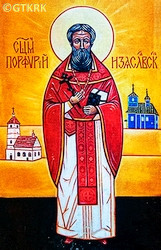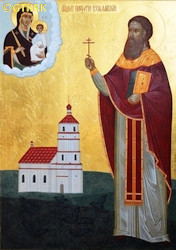Roman Catholic
St Sigismund parish
05-507 Słomczyn
85 Wiślana Str.
Konstancin deanery
Warsaw archdiocese, Poland
full list:
displayClick to display full list

searchClick to search full list by categories
wyświetlKliknij by wyświetlić pełną listę po polsku

szukajKliknij by przeszukać listę wg kategorii po polsku

Martyrology of the clergy — Poland
XX century (1914 – 1989)
personal data
religious status
saint
surname
RUBANOWICZ
forename(s)
Porfirius (pl. Porfiriusz)

canonisation date
28.10.1999

Council of Bishops of the Belarus Orthodox Church
function
presbiter (i.e. iereus)
creed
Eastern Orthodox Church ORmore on
en.wikipedia.org
[access: 2014.09.21]
diocese / province
Minsk OR eparchymore on
en.wikipedia.org
[access: 2020.09.24]
date and place
of death
1943

alt. dates and places
of death
Gomeltoday: Gomel dist., Gomel reg., Belarus
more on
en.wikipedia.org
[access: 2021.09.17]
details of death
Arrested for the first time by Russian communists in 1928 in Zaslav. Accused of „failure to fulfill obligations to the state”, the statement that described failure to pay exorbitant, impossible to meet, taxes due to the state. Sentenced to 3.5 months. His „punishment” served in prison, prob. in Zaslav or in Minsk, c. 12 km away.
In 1935, the Russian authorities closed down his Zaslav parish church. For the next year, ministered in a small church at the local cemetery.
In 06.1936 forbidden to hold priestly functions, and on 16.06.1936 considered a person „without specific employment” — that is, „unemployed, useless” — and ordered to leave Zaslav with a ban on settling within a radius of 100 km from this city.
Settled down — with wife and two children — in Bykhaw, c. 180 km southeast of Minsk. Lived on savings from the sale of an estate in Zaslav, from vegetables grown on a small plot of land and from fishing — there was no functioning Orthodox church in Bykhaw at that time.
During so‐called The Great Purge, i.e. the genocidal extermination of „enemies of the Russian state” — and prob. so‐called «Polish operation», i.e. the genocidal extermination of all Poles living in the Russian state — arrested on 06.08.1937 in Bykhaw by agents of the genocidal Russian organization NKVD.
Held in prison in Mogilev. Interrogated many times — during one of them, on 07.10.1937, allegedly stated that „is a Pole”. According to available records, behaved with rare courage during interrogations and categorically rejected all the charges brought against him.
On 31.10.1937 appeared before the Russian genocidal «NKVD Troika» kangaroo court, charged with „anti–Russian agitation, spreading provocative rumors about the war, slandering the Russian government and the Russian press”, as well as „praising the enemies of the people while fishing”.
In accordance with Art. 72 of the Penal Code sentenced to 10 years in prison and forced slave labor in Gulag concentration camps.
Held in a camp near Gomel, where slaved extracting and processing peat (the „Bolshevik” peat state company had operated in Gomel since 1930).
Was there when on 22.06.1941, Germany attacked its erstwhile ally, the Russians.
Gomel was captured by the Germans in 08.1941 and was released.
During the German occupation resided and lived in an unknown place. Perished in 1943 in unknown circumstances near Gomel, murdered — according to Russian–language sources — by „partisans”, sometimes referred to as „faithless”, which means Russian communist partisans (several communist partisan groups operated in the area and, among others, took part in the so‐called Gomel–Rechytsa operation, conducting destructive activities in the rear of the front — the Russians recaptured Gomel itself from the Germans on 26.11.1943).
cause of death
murder
perpetrators
Russians
sites and events
Ribbentrop‐MolotovClick to display the description, 11.08.1937 Russian genocideClick to display the description, Great Purge 1937Click to display the description
date and place
of birth
1883

Lemeshevichitoday: Lopatino ssov., Pinsk dist., Brest reg., Belarus
more on
tt.wikipedia.org
[access: 2022.08.05]
alt. dates and places
of birth
1880
presbyter (holy orders)
ordination
22.10.1906

positions held
1936 – 1937
resident — Bykhawtoday: Bykhaw dist., Mogilev reg., Belarus
more on
en.wikipedia.org
[access: 2022.01.06] — after being thrown out of the Zaslaw parish
1935 – 1936
priest — Zaslawyetoday: Minsk dist., Minsk reg., Belarus
more on
en.wikipedia.org
[access: 2021.09.17] ⋄ Kazan Icon of the Mother of God OR church (cemetery) — after his parish church was robbed and closed by Russian communists
protoiereus (Eng. first priest) — Russian Orthodox Church — dignity conferment
dean — Minsk 2nd distr.Orthodox deanery name
today: Minsk city reg., Belarus
more on
en.wikipedia.org
[access: 2020.07.31] OR deanery
1914 – 1935
parish priest — Zaslawyetoday: Minsk dist., Minsk reg., Belarus
more on
en.wikipedia.org
[access: 2021.09.17] ⋄ Transfiguration of the Lord OR parish ⋄ Minsk 2nd distr.Orthodox deanery name
today: Minsk city reg., Belarus
more on
en.wikipedia.org
[access: 2020.07.31] OR deanery
from 1909
parish priest — Dobroslavkatoday: Bobrik ssov., Pinsk dist., Brest reg., Belarus
more on
be.wikipedia.org
[access: 2024.01.26] ⋄ Holy Trinity OR parish
22.10.1906
presbiter (Eng. priest, i.e. iereus) — Russian Orthodox Church — priesthood cheirotonia, i.e. ordination, on 21.10.1906 preceded by deacon cheirotonia
1906 – 1909
teacher — Pinsktoday: Pinsk city dist., Brest reg., Belarus
more on
en.wikipedia.org
[access: 2022.07.16] ⋄ church songs, Orthodox Theological School
till 1906
student — Minsktoday: Minsk city reg., Belarus
more on
en.wikipedia.org
[access: 2020.07.31] ⋄ philosophy and theology, Orthodox Theological Seminary
student — Pinsktoday: Pinsk city dist., Brest reg., Belarus
more on
en.wikipedia.org
[access: 2022.07.16] ⋄ Orthodox Theological School
married — at least two children
sites and events
descriptions
Ribbentrop‐Molotov: Genocidal Russian‐German alliance pact between Russian leader Joseph Stalin and German leader Adolf Hitler signed on 23.08.1939 in Moscow by respective foreign ministers, Mr. Vyacheslav Molotov for Russia and Joachim von Ribbentrop for Germany. The pact sanctioned and was the direct cause of joint Russian and German invasion of Poland and the outbreak of the World War II in 09.1939. In a political sense, the pact was an attempt to restore the status quo ante before 1914, with one exception, namely the „commercial” exchange of the so‐called „Kingdom of Poland”, which in 1914 was part of the Russian Empire, fore Eastern Galicia (today's western Ukraine), in 1914 belonging to the Austro‐Hungarian Empire. Galicia, including Lviv, was to be taken over by the Russians, the „Kingdom of Poland” — under the name of the General Governorate — Germany. The resultant „war was one of the greatest calamities and dramas of humanity in history, for two atheistic and anti‐Christian ideologies — national and international socialism — rejected God and His fifth Decalogue commandment: Thou shall not kill!” (Abp Stanislav Gądecki, 01.09.2019). The decisions taken — backed up by the betrayal of the formal allies of Poland, France and Germany, which on 12.09.1939, at a joint conference in Abbeville, decided not to provide aid to attacked Poland and not to take military action against Germany (a clear breach of treaty obligations with Poland) — were on 28.09.1939 slightly altered and made more precise when a treaty on „German‐Russian boundaries and friendship” was agreed by the same murderous signatories. One of its findings was establishment of spheres of influence in Central and Eastern Europe and in consequence IV partition of Poland. In one of its secret annexes agreed, that: „the Signatories will not tolerate on its respective territories any Polish propaganda that affects the territory of the other Side. On their respective territories they will suppress all such propaganda and inform each other of the measures taken to accomplish it”. The agreements resulted in a series of meeting between two genocidal organization representing both sides — German Gestapo and Russian NKVD when coordination of efforts to exterminate Polish intelligentsia and Polish leading classes (in Germany called «Intelligenzaktion», in Russia took the form of Katyń massacres) where discussed. Resulted in deaths of hundreds of thousands of Polish intelligentsia, including thousands of priests presented here, and tens of millions of ordinary people,. The results of this Russian‐German pact lasted till 1989 and are still in evidence even today. (more on: en.wikipedia.orgClick to attempt to display webpage
[access: 2015.09.30])
11.08.1937 Russian genocide: On 11.08.1937 Russian leader Stalin decided and NKVD head, Nicholas Jeżow, signed a «Polish operation» executive order no 00485. 139,835 Poles living in Russia were thus sentenced summarily to death. According to the records of the „Memorial” International Association for Historical, Educational, Charitable and Defense of Human Rights (Rus. Международное историко‐просветительское, правозащитное и благотворительное общество „Мемориал”), specialising with historical research and promoting knowledge about the victims of Russian repressions — 111,091 were murdered. 28,744 were sentenced to deportation to concentration camps in Gulag. Altogether however more than 100,000 Poles were deported, mainly to Kazakhstan, Siberia, Kharkov and Dniepropetrovsk. According to some historians, the number of victims should be multiplied by at least two, because not only the named persons were murdered, but entire Polish families (the mere suspicion of Polish nationality was sufficient). Taking into account the fact that the given number does not include the genocide in eastern Russia (Siberia), the number of victims may be as high as 500,000 Poles. (more on: en.wikipedia.orgClick to attempt to display webpage
[access: 2016.03.14])
Great Purge 1937: „Great Terror” (also «Great Purge», also called „Yezhovshchyna” after the name of the then head of the NKVD) — a Russian state action of political terror, planned and directed against millions of innocent victims — national minorities, wealthier peasants (kulaks), people considered opponents political, army officers, the greatest intensity of which took place from 09.1936 to 08.1938. It reached its peak starting in the summer of 1937, when Art. 58‐14 of the Penal Code about „counter‐revolutionary sabotage” was passed , which became the basis for the „legalization” of murders, and on 02.07.1937 when the highest authorities of Russia, under the leadership of Joseph Stalin, issued a decree on the initiation of action against the kulaks. Next a number of executive orders of the NKVD followed, including No. 00439 of 25.07.1937, starting the liquidation of 25,000‐42,000 Germans living in Russia (mainly the so‐called Volga Germans); No. 00447 of 30.07.1937, beginning the liquidation of „anti‐Russian elements”, and No. 00485[2] of 11.08.1937, ordering the murder of 139,835 people of Polish nationality (the latter was the largest operation of this type — encompassed 12.5% of all those murdered during the «Great Purge», while Poles constituted 0.4% of the population). In the summer of 1937 Polish Catholic priests held in Solovetsky Islands, Anzer Island and ITL BelbaltLag were locked in prison cells (some in Sankt Petersburg). Next in a few kangaroo, murderous Russian trials (on 09.10.1937, 25.11.1937, among others) run by so‐called «NKVD Troika» all were sentenced to death. They were subsequently executed by a single shot to the back of the head. The murders took place either in Sankt Petersburg prison or directly in places of mass murder, e.g. Sandarmokh or Levashov Wilderness, where their bodies were dumped into the ditches. Other priests were arrested in the places they still ministered in and next murdered in local NKVD headquarters (e.g. in Minsk in Belarus), after equally genocidal trials run by aforementioned «NKVD Troika» kangaroo courts.
sources
personal:
drevo-info.ruClick to attempt to display webpage
[access: 2024.01.26], scheglov.byClick to attempt to display webpage
[access: 2024.01.26], martyrs.pstbi.ruClick to attempt to display webpage
[access: 2024.01.26]
bibliographical:
„Hierachy, clergy and employees of the Orthodox Church in the 19th‐21st centuries within the borders of the Second Polish Republic and post–war Poland”, Fr Gregory Sosna, M. Antonine Troc-Sosna, Warsaw–Bielsk Podlaski 2017
original images:
drevo-info.ruClick to attempt to display webpage
[access: 2024.01.26], pravminsk.byClick to attempt to display webpage
[access: 2024.01.26]
LETTER to CUSTODIAN/ADMINISTRATOR
If you have an Email client on your communicator/computer — such as Mozilla Thunderbird, Windows Mail or Microsoft Outlook, described at WikipediaPatrz:
en.wikipedia.org, among others — try the link below, please:
LETTER to CUSTODIAN/ADMINISTRATORClick and try to call your own Email client
If however you do not run such a client or the above link is not active please send an email to the Custodian/Administrator using your account — in your customary email/correspondence engine — at the following address:

giving the following as the subject:
MARTYROLOGY: RUBANOWICZ Porfirius
To return to the biography press below:
 Click to return to biography
Click to return to biography









